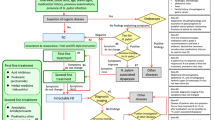Abstract
Background
There is strong evidence that morbid obesity is often accompanied by gastroesophageal reflux. Gastroesophageal reflux is caused predominantly by transient lower esophageal sphincter relaxations (TLESRs). Only few data are available about TLESRs in patients with stage III obesity (body mass index > 35). The aim of this study was to analyze the frequency and types of TLESRs in patients with morbid obesity in different physiological stages (postprandial: upright and recumband) compared to patients with normal weight gastroesophageal reflux disease (GERD) and diffuse esophagus spasm (DES).
Methods
In order to measure TLESRs in obese patients with and without GERD, three subgroups were prospectively performed: group I consisted of seven healthy controls, group II consisted of seven obese patients, group III consisted of seven non-obese patients with GERD, and in group IV, five patients were recruited with diffuse esophageal spasm. All participants underwent both conventional water-perfused stationary esophagus manometry and a 24-h ambulatory esophagus manometry, 24-h ambulatory pH monitoring, and esophago-gastroscopy. In order to measure the lower esophageal sphincter pressure (LESP) over a prolonged time under physiological conditions, a special solid-state sleeve catheter was used. Additionally, all patients were interviewed using a standardized questionnaire.
Results
Compared to normal subjects, patients with morbid obesity and patients with gastroesophageal reflux show a substantial increase of TLESRs in the postprandial phase. There was a tendency towards more TLESRs per hour in patients with DES than in healthy subjects, but the difference was not statistically significant. The types of TLESRs differed with the LESP. The majority of isolated TLESRs were complete and incomplete. Some of the isolated TLESRs were accompanied by contractions of the tubular esophagus.
Conclusion
Morbid obesity is associated with gastroesophageal reflux. The frequency of TLESRs has significantly increased compared to healthy subjects and does not differ statistically from patients with GERD. Isolated TLESRs are mostly incomplete in patients with a hypotonic LES.



Similar content being viewed by others
References
WHO/NUT/NCD. Obesity: preventing and managing the global epidemic. Report of a WHO Consulting on Obesity. Geneva: WHO; 1998.
Spritzer DA. Global health: obesity epidemic migrates east. CMAJ 2004;171:1159.
Brownell KE, Yach D. Lessons from a small country about the global obesity crisis. Glob Health 2006;2:11.
Locke GR 3rd, Talley NJ, Fett SL, et al. Risk factors associated with symptoms of gastro-esophageal reflux. Am J Med 1999;106:642–9.
Fischer BL, Pennathur A, Mutnick JL, et al. Obesity correlates with gastro-esophageal reflux. Dig Dis Sci 1999;44:2290–4.
Nilsson M, Lundegardh G, Carling L, et al. Body mass and reflux oesophagitis: an oestrogen-dependent association? Scand J Gastroenterol 2002;37:626–30.
El-Serag HB, Graham DY, Satia JA, et al. Obesity is an independent risk factor for GERD symptoms and erosive esophagitis. Am J Gastroenterol 2005;100:1243–50.
Kahrilas PJ, Lee TJ. Pathophysiology of gastroesophageal reflux disease. Thorac Surg Clin 2005;15:323–33.
Pandolfino JE, El-Serag HB, Zhang Q, et al. Obesity: a challenge to esophago-gastric junction integrity. Gastroenterology 2006;130:639–49.
Mercer CD, Wren SF, DaCosta LR, et al. Lower esophageal sphincter pressure and gastro-esophageal pressure gradients in excessively obese patients. J Med 1987;18:135–46.
Spechler SJ. Comparison of medical and surgical therapy for complicated gastro-esophageal reflux disease. N Engl J Med 1992;326:786–92.
Chernow B, Castell DO. Diet and heartburn. JAMA 1979;241:2307–8.
Locke GR III, Tally NJ, Fett SL, et al. Risk factors associated with symptoms of gastro-esophageal reflux. Am J Med 1999;106:642–9.
Ruhl CE, Everhart JE. Overweight, but not high dietary fat intake, increases risk of gastro-esophageal reflux disease hospitalization: the NHANES I epidemiologic follow up study. First National Health and Nutrition Examination Survey. Ann Epidemiol 1999;9:424–35.
Lundell L, Ruth M, Sandberg N, et al. Does massive obesity promote abnormal gastro-esophageal reflux. Dig Dis Sci 1995;40:16632–35.
Wilson LJ, Ma W, Hirschowitz BI. Association of obesity with hiatal hernia and esophagitis. Am J Gastroenterol 1999;94:2840–4.
Dent J, Dodds WJ, Frieman RH, et al. Mechanism of gastroesophageal reflux in recumbent asymptomatic human subjects. J Clin Invest 1980;65:256–67.
Holloway RH, Hongo M, Berger K, et al. Gastric distension: a mechanism for postprandial gastroesophageal reflux. Gastroenterology 1985;89:79–784.
Massey BT, Simuncak Ch, Lecapitaine-Dana NJ, et al. Transient lower esophageal sphincter relaxation do not result from passive opening of the cardia by gastric distention. Gastroenterology 2006;130:89–95.
Dent Holloway RH, Toouli J. Mechanism of lower esophageal sphincter incompetence in patients with symptomatic gastro-esophageal reflux. GUT 1988;29:1020–8.
Quiroga E, Cuenca-Abente F, Flum D, et al. Impaired esophageal function in morbid obese patients with gastro-esophageal reflux disease: evaluation with multichannel intraluminal impedance. Surg Endosc 2006;20:739–43.
Schneider JH, Crookes P, Becker HD. Four-channel sleeve catheter for prolonged measurement of the lower esophageal sphincter pressure. Dig Dis Sci 1999;12:2456–61.
Locke GR III, Tally NJ, Fett SL, et al. Risk factors associated with symptoms of gastro-esophageal reflux. Am J Med. 1999;106:642–9.
Mittal RK, McCallum RW. Characteristics and frequency of transient relaxations of the lower esophageal sphincter in patients with reflux esophagitis. Gastroenterology 1988;95:593–9.
Jaffin BW, Knoepfmacher P, Greenstein R. High prevalence of asymptomatic esophageal motility disorders among morbidly obese patients. Obes Surg 1999;9:390–5.
Schneider JH, Kramer KM, Königsrainer A, et al. The lower esophageal sphincter strength in patients with gastro-esophageal reflux before and after laparoscopic Nissen fundoplication. Dis Esophagus 2007;20:58–62.
Wu JCH-Y, Mui L-M, Cheung CM-Y, et al. Obesity is associated with increased transient lower esophageal sphincter relaxation. Gastroenterology 2007;132:883–9.
Author information
Authors and Affiliations
Corresponding author
Rights and permissions
About this article
Cite this article
Schneider, J.H., Küper, M., Königsrainer, A. et al. Transient Lower Esophageal Sphincter Relaxation in Morbid Obesity. OBES SURG 19, 595–600 (2009). https://doi.org/10.1007/s11695-009-9809-7
Received:
Accepted:
Published:
Issue Date:
DOI: https://doi.org/10.1007/s11695-009-9809-7




